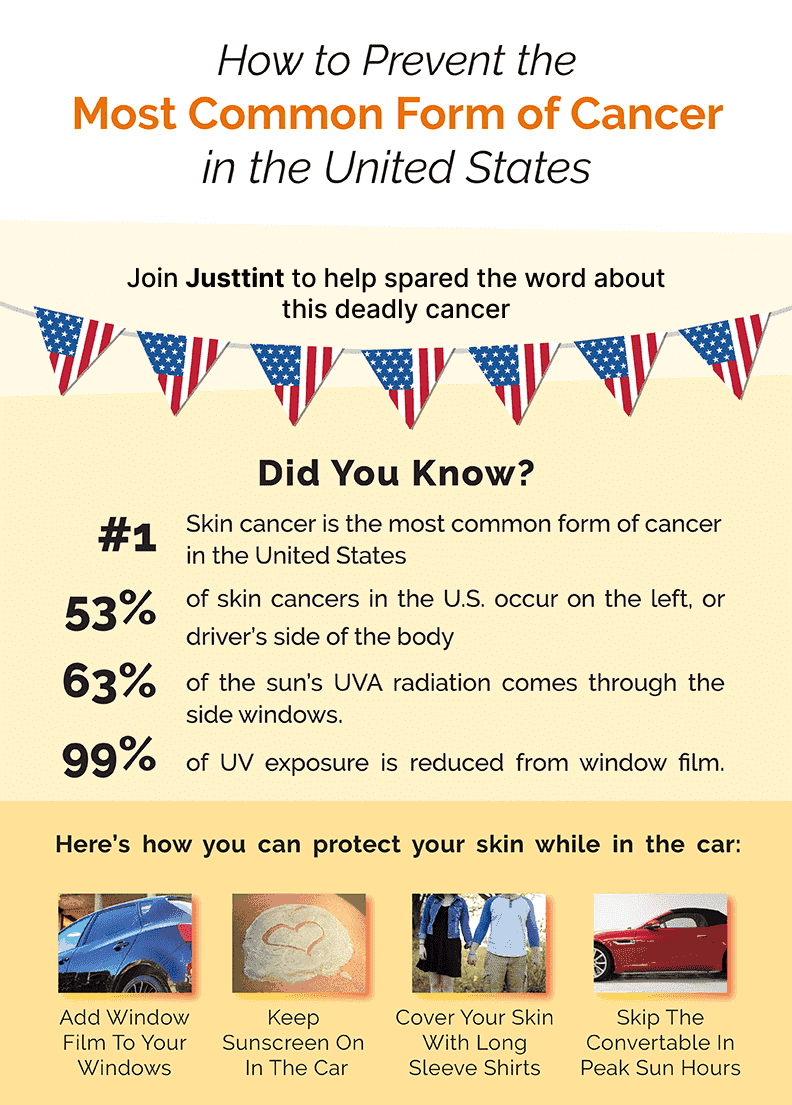Window Tint and Skin Cancer: Separating Fact from Fiction
Skin Cancer Facts:
Can window tint effectively protect skin against sun-damage?
As we delve into National Skin Cancer/Melanoma Awareness Month, it’s crucial to recognize the alarming statistics surrounding skin cancer in the United States. With more individuals diagnosed with skin cancer annually than all other cancers combined, the need for effective prevention measures becomes increasingly urgent.
The most recent data discloses that…
Prevalence: Shockingly, one in five Americans will develop skin cancer before the age of 70, emphasizing the widespread nature of this health concern.
Demographic Considerations: While the risk factor for skin cancer is relatively low for African Americans, Latinos, and Asians, it’s essential to note that it can still be deadly within these groups. Awareness and preventive measures are vital for everyone, regardless of skin type.
Gender Disparity: The American Cancer Society highlights a noteworthy statistic – men are twice as likely to develop skin cancer compared to women, underscoring the need for targeted preventive strategies.
Economic Impact: The economic burden of treating skin cancer is staggering, with an annual expenditure of $8.1 billion in the United States. A breakdown reveals $3.3 billion allocated for melanoma and $4.8 billion for non-melanoma skin cancers. This financial strain emphasizes the importance of cost-effective preventive measures.
Rising Incidence: The diagnosis of nonmelanoma skin cancers has surged by 77% between 1994 and 2014, signaling a critical need for heightened awareness and effective preventive interventions.
UV Radiation Connection: Over 90% of skin cancer cases are attributed to exposure to ultraviolet (UV) radiation from the sun. While many associate sun safety with outdoor activities, it’s essential to recognize the significance of indoor UV exposure.

How Can I Safeguard Myself Against UV Rays?
Regrettably, many individuals overlook this aspect, only to rue the consequences later in life. Taking proactive steps to shield your skin during sun-drenched drives is imperative. Window tinting emerges as a practical solution in such scenarios. Recent studies underscore the correlation between window tinting and skin cancer prevention. A top-notch window tint can significantly diminish the likelihood of skin cancer when driving in sunny conditions. Explore our infographic for intriguing insights on averting the most prevalent form of cancer in the USA while behind the wheel.

Does Window Tinting Help Prevent Skin Cancer?
As skin cancer continues to be a pervasive health concern, exploring innovative and practical prevention measures becomes paramount. One such avenue gaining attention is the application of window tinting as a potential safeguard against skin cancer. While traditional sun safety practices focus on outdoor exposure, the role of indoor UV radiation cannot be underestimated. In this context, the question arises: Does window tinting hold the key to preventing skin cancer?
To comprehend the potential benefits of window tinting in preventing skin cancer, it’s essential to recognize the ubiquitous nature of UV radiation. More than 90% of skin cancer cases are attributed to exposure to these harmful rays, and they are not limited to outdoor environments. Windows, whether in homes, vehicles, or workplaces, permit the passage of UV radiation, contributing to cumulative sun damage. This underscores the need for an effective solution that addresses both outdoor and indoor exposure risks.
Window tinting emerges as a promising ally in the fight against skin cancer. By applying tinted films to windows, individuals can significantly reduce the penetration of UV rays into indoor spaces. This not only helps in maintaining a more comfortable environment but also acts as a practical preventive measure. The tinting process involves blocking or absorbing a significant portion of UV radiation, thereby lowering the overall exposure risk. It is a proactive step towards creating sun-safe spaces beyond the traditional focus on outdoor sun protection.
In conclusion, while no single measure can guarantee absolute protection against skin cancer, window tinting offers a tangible and accessible strategy for reducing UV exposure. As we navigate National Skin Cancer/Melanoma Awareness Month and consider the staggering statistics associated with this health issue, the role of window tinting becomes even more relevant. Embracing such preventive measures contributes to a comprehensive approach in mitigating the risk of skin cancer, underlining the importance of awareness, education, and practical interventions in safeguarding our skin health.
How Does Window Tinting Block UVA And UVB Radiation?
Film Composition
Window tinting films consist of materials that absorb or reflect UVA and UVB rays.
Nano-Technology
Innovative nano-particles in tinting films act as a physical barrier, blocking harmful UV radiation.
Darker Tints
The darkness of the film directly correlates with its ability to block higher percentages of UVA and UVB rays.
UV Absorption
Specialized coatings on tinting films absorb and neutralize UV radiation, preventing it from passing through.
Multiple Layers
Some advanced window tints use multiple layers to enhance UV protection and durability.
Professional Installation
Proper installation ensures a seamless, UV-resistant seal, maximizing the film's efficacy in blocking UVA and UVB radiation.

